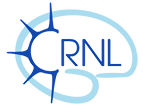Neural Network Dynamics
We have been studying the brain network dynamics for many years using different approaches including Magnetoencephalography, Electroencephalography (EEG) and intracranial EEG in humans as well as cell population and single unit recordings in laboratory animals. We have been exploring the hallmark characteristics of oscillatory activities, i.e. rhythms at different frequencies, in brain networks underlying major cognitive functions such as perception, executive control, attention or memory (in various sensory modalities). Beyond this view of oscillations as a marker of activity, our long-term goal is to go a step further and to determine whether the rhythmical nature of oscillations is a fundamental factor for implementing the plethora of computations achieved by the brain. This complex issue requires a multi-level, multimodal, transversal and translational approach. The CRNL is bringing together teams that can tackle this issue collectively from different angles.
This working group, composed of researchers working on different species and using different complementary tools, aims to determine the essential role of brain oscillations by (1) developing and testing new hypotheses thanks to refined protocols combined with computational approaches (2) studying the cellular basis of oscillations using cutting-edge techniques combining two-photon microscopy and optogenetics to manipulate neuronal activity (3) testing the causal link between oscillations and functions using repetitive transcranial magnetic stimulation (rTMS), transcranial Alternating Current Stimulation (tACS) in humans, optogenetics in laboratory animals or by entraining neuronal oscillations with an external rhythm and finally (4) studying the development over time of alterations observed in different states (e.g. meditation) or in psychiatric and neurological disorders. One asset of the CRNL is the large array of neurological/psychiatric disorders studied.
These questions will be tackled through collaborations within the CRNL, favored through a monthly journal club (“JC oscillations”, JCO; since early 2020). Those JCO are dedicated to present papers (both from the animal and human literature) and new data/projects. We will further organize meetings to specifically discuss emerging questions to be addressed in the different species and modalities we study. The goal is to set-up collaborative projects and seek synergistic grants to fund them.
The JCO started in 2020 and notably led to fruitful discussions regarding the role of beta bursts (~20Hz) in the somatosensory domain and in learning in general. We also discussed the role of theta oscillations and faster rhythms in episodic memory and decision making. Many collaborations have already been set-up (including with neighboring institutes). For instance, a collaboration has been set-up between CMO and Cophy on the role of the respiratory rhythm in brain networks rhythms associated with visual/olfactory cognition in rats and humans. Another ongoing collaboration is between TIGER and CMO on the cerebral dynamics associated to encoding and retrieval of associations in epileptic patients suffering from long term accelerated forgetting.
We expect the JCO to continue and the meetings to result in projects leading to fruitful collaborations between CRNL members, in particular between groups working on animals and humans. Moreover, we plan to set-up a mentoring program. The idea is to help CRNL researchers 1) through personalized discussions and reading of project proposals (search for mentor will be achieved via an internal survey) and 2) by sharing resources and knowledge via training and code sharing (in collaboration with the club methodo of the CRNL). Finally, using a similar organization, we wish to attract external researchers who are themselves experts on oscillations, possibly with original and complementary approaches to the ones already existing within the CRNL. This will be achieved via an invitation to give a talk followed by several discussions with a chosen group of local researchers.
Emmanuelle Courtiol (CMO CRNL), emmanuelle.courtiol@cnrs.fr
Mathilde Bonnefond (COPHY CRNL), mathilde.bonnefond@inserm.fr











